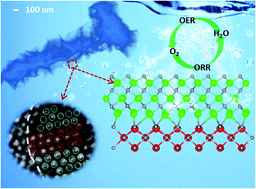Distorted quantum dots enhance the efficiency of alkaline oxygen electrocatalysis†
Abstract
Highly dispersed quantum dots with efficient catalytic activity continue to be of great interest in the research of electrocatalytic materials. Herein, we report a caterpillar-like nanostructure self-assembled from porous vanadium nitride nanosheets, which were uniformly decorated with ultrafine nickel nitride quantum dots. Detailed structural and chemical investigations verified that the VN substrate distorts the Ni3N lattice fringes due to strong interatomic interaction at the interface, in which case a low match heterostructure is simultaneously generated. The successful construction of Ni3N QDs chemically coupled with porous vanadium nitride (VN) nanosheets allowed realizing rapid charge transfer and mass transport. Especially, the distorted QD configuration with a modified chemical state played a vital role in enhanced oxygen electrocatalysis performance, thereby, making the material highly efficient for catalyzing oxygen reduction/evolution reactions. Featuring a small overpotential, rapid electrode kinetics, and excellent structural durability, the synthesized D-Ni3N QDs/VN was superior to most transition metal nitrides previously reported. This discovery opens a completely new avenue for elevating oxygen-involving reactions by taking advantage of structural distortion effects in hybrid nanomaterials.



 Please wait while we load your content...
Please wait while we load your content...